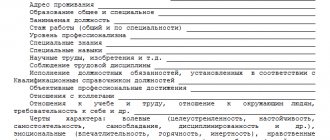Signs of business fragmentation
With the development of tax legislation, the optimization of the activities of commercial organizations is also improving.
Legal entities adapt to changes in legislation, looking for options to reduce the cost of mandatory payments. The main intention of legal entities in this case is the transition from VAT to the simplified tax system or UTII. Business fragmentation is one of the behavioral models that helps reduce the financial burden; its use is fraught with attracting close attention from the tax authorities. At the legislative level, the concept of business fragmentation and its consequences is not disclosed, but based on judicial practice, it can be formulated. This is the assignment of the functions of a legal entity to controlled organizations in order to obtain tax benefits and reduce costs. Let's take a diagram as an example.
Legal regulation is based on clarifications of the Federal Tax Service of the Russian Federation in Letters No. SA-4-7/ [email protected] dated 10/11/2017, No. KCh-4-7/14643 dated 07/30/2018, No. ED-4-9/ [email protected] dated 10/31/2017.
The legality of the separation of legal entities lies on the border between legal activity and violation of the law. The question arises: is business fragmentation a legal optimization or a tax crime? To answer it, the tax authority is obliged to identify the goal pursued by the taxpayer and prove the lack of independence and control of the companies:
- If the main goal is to change the taxation system and obtain tax benefits, there is an abuse of law on the part of the organization, and it is held accountable.
- In case of separation for the purpose of preserving independent production and entrepreneurial activities, there is no offense.
Consequences of business fragmentation in 2020 for the purpose of tax evasion
In the end, it is worth mentioning the responsibilities for the managers and founders of the company, which is divided into several companies in order to minimize tax payments and obtain unjustified tax benefits:
- institution of a criminal case under Article 199 of the Criminal Code of the Russian Federation against the founders and managers of the organization (terminates only after full repayment of fines, penalties and additional taxes);
- imposition of a fine, assignment of penalties, additional assessment of taxes (40% of the unpaid amount) under Art. 122 of the Tax Code of the Russian Federation.
Signs of crushing
Actions to change the structure of the organization and thereby get rid of paying taxes attract the attention of regulatory authorities. The taxpayer abuses his right to avoid a statutory obligation. To suppress such actions, the Federal Tax Service of the Russian Federation sent Letter No. SA-4-7/ [email protected] dated August 11, 2017, which indicates by what signs inspectors will detect business fragmentation, with examples from arbitration practice.
The following signs are distinguished:
| Sign | Characteristic | Arbitrage practice |
| Location at one address. | Legal entities have a common legal or postal address. | Resolution of the Sixteenth Arbitration Court of Appeal dated July 20, 2018 No. 16AP-2479/2018 |
| Availability of common services and employees who accompany the activities. | Separate divisions are created to service the entire system of companies. For example, accounting and personnel selection. | Resolution of the Eleventh Arbitration Court of Appeal dated January 22, 2019 No. 11AP-19422/2018 |
| Sending tax reports and other documents from one IP address. | Transfer of documents from different organizations to the tax authority using one digital signature and IP address. | Resolution of the Sixth Arbitration Court of Appeal dated October 8, 2018 No. 06AP-4304/2018 |
| A single type of economic activity. | The activities of legal entities have a general focus. | Resolution of the Third Arbitration Court of Appeal dated August 20, 2018 in case No. A74-13176/2016 |
| Use of unified communication contacts. | When contacting government agencies, the same contact information is indicated: email, telephone, postal address. | Resolution of the Fifth Arbitration Court of Appeal dated November 8, 2018 No. 05AP-6345/2018 |
| Presence of one leader. | The main and controlled organizations have the same founders or managers. | Resolution of the Arbitration Court of the East Siberian District dated July 23, 2019 No. F02-2544/2020 |
As of 2020, judicial practice on business division has developed in such a way that the regulatory authority identifies several signs of division at once (Determination of the Supreme Court of the Russian Federation No. 304-KG18-11923 dated 08.21.2018 and No. 302-KG17-2263 dated 06.05.2017). The more signs of affiliation, the more likely it is that when a taxpayer challenges a tax authority’s decision in court, the court will accept the position of the government agency.
Business fragmentation: how to protect yourself from tax risks
The legislation does not contain the term “business fragmentation”. However, from business practice it can be understood that this is a kind of business restructuring, during which several companies are created or several entrepreneurs are registered, to which some of the functions previously performed by one company are transferred. There can be a lot of reasons for fragmentation - from diversification of risks and decentralization of management of the entire business structure to saving on taxes. It is the latter reason that attracts increased interest from inspectors.
It is not uncommon for business owners to decide to split it up in order to direct part of the cash flows to new subsidiaries or to interdependent entrepreneurs who apply reduced rates under special taxation systems. As a result of this, tax is not paid on revenue at a rate of 20%, but only 15% or even 6%, which allows for significant savings on taxes. This occurs by taking advantage of special taxation systems that were previously not available due to the significant financial turnover of the main company, which is forced to use the general taxation system.
But don't be fooled into thinking that there are no downsides to this kind of business restructuring. When inspectors learn about such business fragmentation, they charge the main company additional arrears for VAT and income tax, based on the revenue of all subsidiaries that apply special tax regimes (special regimes). At the same time, inspectors do not take into account the amount of expenses incurred by the subsidiary company. Moreover, when calculating taxes on the main company under the general taxation system, taking into account the revenue of subsidiaries, tax authorities do not take into account the amount of tax they paid. It turns out that you will have to pay tax twice on the same income:
- the first time the subsidiary company that received the proceeds will pay,
- the second time - the main company to which the arrears were accrued, based on the amount of this revenue.
Thus, splitting a business has a high level of tax risk.
Let's try to figure out exactly how this happens. Tax authorities believe that such subsidiaries work together with the main company and are a single business. Accordingly, the revenue of each company is the total revenue of such a business, which must be taken into account when calculating VAT and income tax. Then inspectors request information from banks about funds received in the accounts of subsidiaries. They will be taken as the basis when calculating the arrears. As a result, the tax authorities will ask not the subsidiaries, but the main company to pay this arrears. If the amount of arrears is significant, then there may be a risk of bringing the management of the main company to criminal liability for tax evasion.
Due to the effective operation of the ASK-VAT-2 program, tax authorities began to quickly identify those used for illegal tax savings. This is largely due to the fact that inspectors have delegated part of their functions for checking VAT returns to this program, which can independently perform the following actions:
- analyze declarations;
- look for discrepancies in VAT amounts for the transaction between the taxpayer and his counterparties;
- formulate requests for explanations in connection with detected violations.
As a result, inspectors have more time to successfully identify schemes for formal division of business due to the presence in the group of companies of firms that apply special tax regimes. This fact has influenced the increase in the number of tax disputes regarding business restructuring.
The division of a business in itself is not prohibited by law and is not a tax offense.
However, the vast majority of tax disputes over business division end in victory for the tax authorities.
Case No. 1.
For example, it created 18 subsidiaries and transferred shares of its furniture trading company to them. These subsidiaries were engaged in leasing the premises of the shopping center. At the same time, they used special tax regimes, whereas the general tax regime was applied. Thanks to these 18 companies, the business owner managed to save on taxes. The inspectors did not like this and, based on the results of the inspection, Karenfor was awarded 795 million rubles. When calculating taxes, the inspectors summed up the revenue of all subsidiaries and calculated taxes according to the general taxation system, obliging Carenfor to pay additional VAT and income tax for these subsidiaries. At the same time, tax authorities, when calculating the VAT arrears, proceeded from the fact that the tax is calculated on top of rental payments, and is not included in them. This approach allowed inspectors to accrue a larger amount of arrears.
The misadventures of “Karenfor” did not end there. A criminal case was opened against its management for tax evasion on an especially large scale. The courts agreed with the inspectors’ conclusions about the formal nature of the division of the business, the purpose of which was to save on taxes (determination of the Supreme Court of the Russian Federation dated May 31, 2019 in case No. A40-195593/2017 ). Probably, what worked in favor of the tax authorities was that the rental income from the subsidiaries was immediately sent to the account of Carenfor, the management of the shopping center was carried out by Carenfor itself, and the staff of the subsidiaries was formed from former employees of Carenfor.
Case No. 2.
The central link in the division of a business is not always the company that applies the main tax regime. Sometimes an entrepreneur can divide his business into parts and transfer it to his subsidiaries, which use special regimes. A similar situation was considered in case No. A41-48348/2017. The entrepreneur created 12 companies that were engaged in the production and sale of jewelry under the “Golden Domes” trademark. Wholesale and retail sales are carried out in many cities, including Moscow, Nizhny Novgorod, St. Petersburg, Minsk. Inspectors came to the businessman and discovered that all the companies were actually located at the same address, operated under a common brand, and collaborated with the same contractors. The inspectors also proved that the entrepreneur’s employees worked part-time in several companies in which they performed the same duties. The result of the tax audit was the accrual of VAT and personal income tax to the entrepreneur, based on the calculation as if his companies had not applied special regimes. The total amount of additional charges amounted to over 152 million rubles. The entrepreneur did not agree with this decision of the tax authorities and went to court. There he tried to convince the judges that the fragmentation of the business was due to the sectoral isolation of each one. But the courts agreed with the point of view of the inspectors and recognized such a division of business as formal (determination of the Supreme Court of the Russian Federation dated September 2, 2019 in case No. A41-48348/2017).
Case No. 3.
We will also consider a case in which Avtomir LLC sued the tax authority.
The taxpayer (Avtomir LLC) owns the building of a shopping center and applies the simplified tax system for leasing premises. The company also uses UTII for retail trade. Based on the results of the on-site tax audit, the division of the business was established between three (Avtoshina LLC, Autocentre LLC) and one entrepreneur. The founder of all companies is the same person. And the entrepreneur is an employee in all these companies.
Based on the results of the audit, the company was assessed additional VAT, corporate income tax and property tax, as well as penalties and fines totaling over 160 million rubles.
It follows from the Tax Code that in order to retain the right to use UTII, retail space should not exceed 150 square meters. meters. Whereas in the case under consideration, the area of the entire building significantly exceeded this value. According to the inspectorate, she did not have the right to apply UTII. At the same time, part of the space was leased to the above-mentioned interdependent organizations and an entrepreneur. However, the tax authorities considered these lease agreements to be fictitious.
As the inspection established during the inspection of the shopping complex, none of the leased areas represented an independent retail outlet with a trading system independent from others. The rented areas of the trading floor are not structurally separated from each other, and the store had a common entrance and exit, with a common sign and a uniform operating mode. In addition, the store has a common cash register area.
During the audit, it was established that property was being withdrawn from the fixed assets of Avtomir LLC in order to preserve the right to apply the simplified tax system, namely the sale of the building. The inspection also found that all companies and the entrepreneur had common suppliers and carriers, advertising of common products was paid for by one organization, and all interdependent persons kept a common record of revenue.
All these circumstances served as the basis for the conclusion about the formal division of retail space and the creation of a business division scheme in order to minimize tax obligations by preserving the right to apply a special regime. The courts completely agreed with the position of the tax authorities (resolution of the Far Eastern District Court of August 8, 2018 in case No. A24-2305/2017).
But not everything is so gloomy. Still, sometimes taxpayers manage to win such disputes.
Case No. 4.
A company applying the general tax regime sold car tires wholesale to controlled merchants. These entrepreneurs used special regimes with low tax rates. They sold tires at retail. Tax officials suggested that such a business shows signs of formal fragmentation. They referred to the fact that the company and entrepreneurs have the same website and trademark. In addition, their accounts are opened in the same bank. The company's employees also worked part-time for the entrepreneurs. However, these arguments of the tax authorities did not convince the court and the taxpayer won the case (Resolution 18 of the AAS dated June 21, 2019 in case No. A76-27603/2017). The company's success in the dispute is due to the fact that it was able to prove the business purpose of such a business model, which is not related to tax savings. In particular, entrepreneurs began to develop services in addition to tire retail. At the same time, the company itself was not engaged in the provision of services and retail trade. The company's benefit is that by stocking tires and other products with a large number of retailers, it reduces the risk of competitors entering the market. That is why the company is actively taking measures to attract a large number of entrepreneurs (small wholesale buyers) who sell tires at retail.
Case No. 5.
In another case, the Vyatka-TSUM joint-stock company leased premises in shopping centers to interdependent persons using special regimes for retail trade. Moreover, until 2001, the joint-stock company carried out trade independently. The abandonment of this type of activity was associated with its unprofitability and the complexity of its implementation within a single shopping center. The inspectorate considered that the taxpayer fragmented the business in order to distribute part of the income received from the sale of goods to interdependent persons using special taxation systems.
The tax authorities' conclusions were based on the following:
- shopping center areas were used in a single and inseparable process and were a single object of trade;
- the shopping center had a single buyer discount card and general marketing campaigns were carried out;
- wages to employees of the taxpayer and interdependent organizations were paid on the same day;
- all interdependent companies were registered and operated at the addresses of the taxpayer and its affiliate LLC Center;
- a common telephone number was used to communicate with counterparties.
Based on the results of the audit, VAT, corporate income tax, property tax, penalties and fines amounting to more than 180 million rubles were assessed. The courts of all instances did not agree with the opinion of the inspectors and recognized the decision to accrue arrears as unlawful, since the fragmentation of the business is not associated with an unjustified tax benefit (decision of the Supreme Court of the Russian Federation dated December 15, 2017 in case No. A28-5839/2016). This point of view is supported by the following arguments:
- over the course of 15 years, the area and location of rented premises in the shopping center have changed;
- they were separated by partitions, the stores had independent cash settlement units, cash register equipment was assigned to each organization;
- from the moment the tenants were formed, the composition of their employees was formed independently, and not at the expense of the taxpayer’s personnel;
- there was no evidence that she controlled the activities of interdependent organizations to a greater extent than is provided by law for the founders of companies.
To improve the efficiency of inspectors, the tax service summarizes and systematizes approaches to identifying formal business fragmentation. For example, in the letter of the Federal Tax Service of Russia dated August 11, 2017 No. SA-4-7 / [email protected] , 17 key signs are highlighted that help inspectors detect the formal division of a business. Tax authorities include the following factors among these signs:
- one business is split between several individuals using special regimes, instead of the main company calculating and paying taxes according to the general taxation system;
- as a result of applying the scheme, the tax obligations of all participants are reduced or practically do not change with the expansion of all activities;
- participants in the scheme were created for a short period of time immediately before expanding production capacity or increasing the number of personnel;
- participants in the scheme bear expenses for each other;
- personnel are formally redistributed between interdependent persons without changing their job responsibilities;
- the participants in the fragmentation lack fixed and working capital and human resources;
- participants use the same signs, designations, contacts, website, addresses, banks;
- the only supplier or buyer for one participant in a business division is another participant, or all participants have common suppliers and buyers;
- the activities of the splitting participants are managed by the same persons;
- accounting, personnel selection, search for suppliers and buyers, legal support, logistics are carried out by one company, and not by each participant in the business division scheme;
- the number of personnel, the occupied area of real estate and the amount of income are close to the limit values for the application of the corresponding special regimes.
However, this list of criteria is not complete. In judicial practice, additional factors have emerged that may indicate a high tax risk during the formal division of a business . These include the following circumstances:
- there are family relationships between the leaders and founders of organizations;
- one participant in the division represents reporting for other organizations;
- the stores are decorated in the same style, there is a uniform system of discounts;
- personnel of newly created organizations are formed at the expense of employees of the main organization;
- advertising costs are assigned to one company;
- the rented areas of the stores are not structurally separated from each other, they act as a single object of trade with a common organizational structure;
- all organizations access the “Bank-Client” from one IP address;
- the right to sign in bank documents of one organization is granted to employees registered in other organizations;
- within companies, fixed assets and products move freely without registration of purchase, sale or rental transactions;
- expenses for the acquisition and insurance of fixed assets are borne by one organization, and income from their operation is received by other participants in the division of the business;
- incoming letters are registered in a general journal with a single continuous numbering;
- there is no division of activities between organizations, the subjects are not organizationally isolated, their activities are part of a single production process aimed at achieving a common result.
We have now listed only the main aspects of fragmentation, which tax inspectors pay close attention to. It is worth noting that the mere presence of one of the listed signs does not indicate a high tax risk. Only if a combination of factors hinting at a formal fragmentation of the business is discovered, can we talk about a high probability of tax claims being filed. To reduce this risk and protect yourself from possible additional tax charges, you can follow some simple rules :
- all organizations participating in the business division carry out independent economic activities;
- tax audits of newly created companies and entrepreneurs should not detect tax violations and circumstances indicating the absence of their real entrepreneurial activity;
- split participants should not provide services for only one main company;
- When executing transactions with related parties, the taxpayer must have business purposes. For example, transfer of low-skilled personnel, increasing sales of non-core goods, reducing costs and improving personnel management;
- there must be a clear and convincing justification for restructuring the business by splitting it up. For example, preparing a business for sale in parts, the need to improve business management, diversifying the risk of raider takeover and optimizing activities by dividing types of trade into wholesale and retail;
- the main company should not act as the sole supplier of goods for new participants in the division;
- When moving to work from one organization to another, workers actually have to quit and take a new job. For the new employer, these employees must actually work and receive a salary;
- all participants in business division must independently fulfill their obligations both to counterparties and to the budget to pay taxes;
- you need to have a justification for the reason why all participants used the same trademark. For example, they could do this on the basis of paid licensing agreements;
- lease agreements between newly registered entrepreneurs, organizations and the main company should not be concluded simultaneously, but over a long period of time;
- it is necessary that contracts with interdependent parties be similar to transactions previously concluded by the main company with other counterparties.
The decisive factor that can protect a restructured business from unjustified additional tax charges is the presence of a real business purpose for such fragmentation. This goal can be expressed in expanding the sales market by attracting buyers who apply the general taxation system, who are interested in the presence of VAT in the price of goods, and buyers of retail chains. The last category of buyers is not interested in the presence of VAT in the price of the product. As a result, retail buyers may be able to deal with companies that have special tax regimes.
If the purpose of splitting a business is purely business, then this is not enough to minimize tax risks. It is necessary to have documentary evidence that this particular goal was pursued by the business owners, and not tax savings. The following documents may be evidence of a justified division of a business :
- an order from the head of the main organization about the intention to create new companies with the aim of expanding the sales market, reorienting the specifics of the company’s work to other areas or other business goals;
- a market research report showing that brand awareness, customer flow and market share increased after business fragmentation;
- analytical report on the lack of tax savings as a result of business fragmentation. So, this report may contain a comparison of the amount of taxes paid by the main company for the year preceding the split and general information about the taxes of all participants in the split, including the main company and the newly created ones. This will help convince inspectors that as a result of fragmentation, the tax burden on the business has increased. Therefore, the underlying company could not realize an undue tax benefit after restructuring its business model.
To summarize, it should be noted that business fragmentation is associated with both advantages and risks that must be predicted and taken into account when making management decisions. If your group of companies has several organizations and they use special regimes, then this is a reason to analyze your tax risks and assess the likelihood of tax claims due to business fragmentation.
Telegram channel “Taxes and Law”
How much will you have to pay for violation?
The division of a business while maintaining signs of affiliation for the purpose of extracting tax benefits is qualified by the tax authorities under clause 1 and clause 3 of Art. 122 of the Tax Code of the Russian Federation. The organization must pay a fine, which depends on the amount of unpaid tax and ranges from 20 to 40 percent.
All companies included in the affiliation group may be among the entities subject to punishment. As a measure of responsibility, additional taxes are used when splitting up a business; inspectors have the right to carry out such an action for each legal entity. In this case, the regulatory authorities will have to prove the amount of obligations based on primary documents. Current legislation does not provide for criminal liability for business fragmentation. According to criminal law, qualification under Art. 199 of the Criminal Code of the Russian Federation - tax evasion, then the tax inspector is obliged to send information to the investigative authorities.
What are the risks of illegal business division?
The implementation of illegal and dubious schemes can lead to the collapse of a commercial project. The standard scenario is the accrual of arrears, penalties and fines based on the results of an on-site inspection. Higher authorities reject administrative complaints, and the case is referred to state arbitration. If it is not possible to challenge the inspection findings, the debt must be repaid in full. Failure to fulfill obligations leads to bankruptcy.
A striking example of such developments is the history of JSC Nydinskoye. The management of the association did not take into account the tax risks of splitting up the business. The result of unsuccessful optimization was the lawsuit A81-1044/2016. The proceedings ended in defeat for the company. The cassation cassation of the West Siberian District confirmed the validity of the inspectorate's decision in the main part (resolution dated December 26, 2017). The company was unable to pay off the arrears. Subsequently, it was the tax service that applied to the arbitration court of the Yamalo-Nenets Autonomous Okrug with a statement of bankruptcy of the organization (A81-10004/2018).
The expected consequences of violating the rules of business division are criminal cases. Persecution under Art. 199 of the Criminal Code of the Russian Federation threatens:
- immediate managers of the organization;
- chief accountant;
- founders;
- other persons controlling the company.
The condition for initiating a case is evasion of taxes (fees) for a 3-year period in the amount of 5 million rubles. The share of arrears should be ¼ of the company’s total liabilities to the budget or government funds. Criminal prosecution is also threatened if the total debt reaches 15 million in domestic currency.
Judicial practice in this area is widely represented. An example of a traditional approach is the verdict of the Zaeltsovsky District Court of Novosibirsk in case 1-386/2015 dated 10/15/15. The directors of the company were brought to criminal liability precisely for illegal division of the business.
If the guilt of an official or controlling person in the formation of tax arrears is confirmed in court, liability for debts will become subsidiary. This approach is practiced in bankruptcy of organizations. Its relevance was confirmed by the Supreme Court of the Russian Federation by Resolution No. 53 of December 21, 2017.
Commonly used illegal crushing schemes
In life there are schemes that are much more sophisticated and complex. However, when parsed, everything comes down to simple elements. And, let's make a reservation that what is described in this section is already known to the tax authorities, and is already considered illegal for obtaining tax benefits. So if you just came up with one of these schemes to cut taxes, you are planning to break the law.
Creation of individual entrepreneur simplified tax system 6%, concluding with him an imaginary contract for the provision of services
The main legal entity for 15% of profits. Withdrawing money costs 15+13%. They make an individual entrepreneur using the simplified tax system at 6% and withdrawing money costs 7% (1%+6%). Savings - 18% from the withdrawn turnover.
Several persons are on the simplified tax system, and the combined turnover is more than 150M
A turnover of more than 150M obliges the use of OSNO. Splitting into 2 different legal entities makes it technically possible to apply the simplified tax system. Savings - at least 25% of profit (20% VAT and 5% of profit).
Several persons on UTII, but in conjunction with UTII it is not permissible in terms of the number of cars or area;
Retail store, area 200 square meters. With a turnover of 10M per month and a profitability of 30%, the tax under the simplified tax system of 15% would be 5.4M per year. And UTII from individuals after crushing is a little more than 1M per year. Savings of more than 4M per year.
LLC + employees for individual entrepreneurs
Transferring employees to individual entrepreneurs is a special case of business fragmentation. Savings - 43% from the salary fund. You can read more about this here: Is it possible to transfer employees to individual entrepreneurs?
Allocation of a preferential type of activity into a separate legal entity
For example, in the IT sector, in order to receive benefits on insurance premiums, it is required that at least 90% of the revenue come from IT projects (clause 3, clause 1, article 427 of the Tax Code of the Russian Federation). If a company is engaged in several types of activities, for example, creating websites and their promotion and advertising, it may not be included in the revenue and may not receive a benefit. Spin-off into a separate legal entity will allow you to maintain the benefit and save 16% from your payroll, but this is illegal.
Another example. The individual entrepreneur operates on a patent. On a patent, the revenue limit is 60M per year, with revenue from 60M to 150M you need to apply the simplified tax system. The cost of an annual patent for an information businessman in Moscow is 19,800 rubles. for a year. The cost of tax according to the simplified tax system with 60M is 3.6M. In order to avoid paying tax, such an individual entrepreneur transfers flows to a “friendly individual entrepreneur.” Savings could amount to millions per year.
What threatens: court cases and consequences of fragmentation
Over the past 5 years, the courts have considered more than 400 cases worth more than 12 billion rubles. A rich judicial practice has been formed, on which we can rely in our activities.
Case #1. Master-Tool and sales division. Punish.
sold instruments wholesale, retail and through an online store. Retail outlets were registered as individual entrepreneurs and used UTII. The online store was separated into a separate legal entity. The main company was engaged in purchasing and distributing goods to points with a minimum margin, with which it paid taxes according to the general system. All actors acted under a single brand, logo and the same sign, and used a common base of products.
Based on the results of the audit, an additional 200 million taxes were assessed. The company was unable to pay this money and went bankrupt.
Resolution of the Volga District Arbitration Court dated April 15, 2016 in case No. A12-15531/2015.
Case #2. Kurskkhleb plant and nine individual entrepreneurs. Justify.
OJSC Kurskkhleb sold its goods through nine controlled individual entrepreneurs using either the simplified tax system or OSNO with VAT 10% (reduced VAT rate). Individual entrepreneurs rented premises from Kurskhleb and sold its bread further at retail. Inspectors came and found nine people at work on the premises of the plant, and considered it a tax evasion scheme. They say that individual entrepreneurs are employees, but Kurskkhleb is evasive. The case went to court.
In favor of Kurskkhleb was the fact that the contractors of the individual entrepreneurs clearly confirmed that they worked with these people, and not with the plant. This is what made the fact of cooperation real and the scheme legitimate. The plant argued for such a sales organization with a large number of end customers, the volume of which it could not cope with.
Against Kurskkhleb. The first fact is that the individual entrepreneurs were located on the territory of the plant and conducted their activities from there. Second, individual entrepreneurs applied preferential tax regimes.
The court said that the state does not have the right to dictate to a business how to build its processes, if these processes are real. The additional assessment was canceled, the case stopped at the second instance, on appeal. The case did not go to cassation.
Resolution of the Nineteenth Arbitration Court of Appeal dated March 7, 2020 in case No. A35-9175/2016.
Case #3. MAN and general cash register. Punish.
The MAN company was engaged in the sale of goods. In the premises she owned, she allocated a piece of space and rented it out to entrepreneur B for UTII. MAN entered into a contract of agency with the entrepreneur for the sale of its goods. And the entrepreneur, in turn, also entered into a similar contract of authority for the sale of his goods with MAN.
Companions used a single cash line; customers were given a common cash receipt, even if the goods belonged to different suppliers. Used common warehouse and retail space. The showcases were decorated in the same style. The proceeds were accounted for in the same program and collected jointly. The goods were purchased from the same suppliers, stored at the MAN warehouse, unloaded and stored by MAN employees, but the entrepreneur did not have such facilities. Employees perceived the Company and the entrepreneur as a single entity and worked for both at the same time. The Society was the only source of income for the entrepreneur.
The court considered the evidence sufficient and decided to collect sanctions from the Company in the amount of more than 361M, incl. income tax 124M, VAT 144M, fines and penalties 93M.
Ruling of the Supreme Court of the Russian Federation dated November 27, 2015 No. 306-KG15-7673 in case No. A12-24270/2014.
Case No. 4. Vostokpromholding and controlled subcontractors. Justify.
The management company carried out transactions with controlled companies using a simplified procedure. Tax officials considered the transactions imaginary and assessed additional income tax of more than 4 million rubles. When calculating additional accruals, the income of controlled companies was included in the income, and the salaries of their employees were included in the expenses. The tax authorities had no other data on expenses, no checks were carried out on controlled legal entities, and no documents were requested. The costs of repairing a car owned by a controlled person were also not taken into account in the calculation, since according to the documents the car does not belong to the person being checked (but belongs to a controlled person).
The court found that the tax authorities did not investigate the activities of controlled companies and did not prove that as a result of fragmentation any tax benefit was obtained, and the controlled companies themselves did not carry out real activities. The controlled companies had their own staff, separate accounting departments, and according to the documents, the activities looked quite real. But the tax authorities did not prove otherwise. The court considered the calculation presented by the tax authorities to be incorrect, since it did not contain data on most of the expenses incurred by controlled companies.
The court decided that tax authorities had the right to conduct additional checks of controlled persons and identify all the circumstances of the case. In the meantime, I have canceled additional charges.
Resolution of the Federal Antimonopoly Service of the East Siberian District in case No. A19-18472/2012 dated June 27, 2013.
Case No. 5. Pharmperspective and a network of retail pharmacies. Justify. .
The Pharmperspektiva company was engaged in supplying medicines to retail pharmacy chains. The pharmacies were registered under the simplified tax system and paid less taxes than Pharmimperspectiva would have paid. Tax officials found that all pharmacies were created in a short period of time, have identical personnel and operate under the same contracts, and they also have the same legal address.
However, the courts decided that there was no illegal crushing here. Pharmacies are not the only buyers of Pharmimperspectiva; they have their own staff, bank accounts and other resources to conduct independent activities. Pharmimperspective does not incur costs for maintaining pharmacies. In addition, Pharmimperspectiva itself has never carried out retail trade in medicines and does not have the appropriate license to do so. Therefore, splitting is legitimate, and additional charges should be abolished.
Ruling of the Supreme Court of the Russian Federation dated 10.10.2014 N 306-KG14-1504 in case N A55-17026/2013 dated 18.06.2014 FAS Volga District.
Case No. 6. Disguised rental.
The entrepreneur owned a premises which he rented out to one client. According to the documents, this took place as a lease from different persons of retail space measuring less than 150 square meters. m., which allowed the lessor to apply UTII for leasing.
The court studied the situation and decided that there were sham transactions with controlled entities and upheld the additional assessment of taxes and sanctions on the entrepreneur.
Ruling of the Supreme Court of the Russian Federation dated April 28, 2015 No. 303-KG15-3130 in case No. A73-2803/2014 dated December 30, 2014 of the Arbitration Court of the Far Eastern District.
Case No. 7. Construction and non-existent construction for 11 companies.
The Stroibilding company carried out the construction of residential apartment buildings. To carry out the work, I hired contractors on a simplified subcontract basis. Tax officials proved that the subcontractors did not have their own resources, 9 out of 11 were registered at the same address, 2 out of 11 at another, but also the same. They had the same accounting department, and the individuals themselves were controlled by Stroibilding. All 11 companies were founded by the mother of the director of the company being audited. The general director in all companies was the same. The chief accountant is the same. The companies carried out mutual settlements among themselves, sent part of the money bypassing the accounts of simplified companies and did not pay taxes on this at all. The fly-by-nights did not have a building permit or resources to carry out the work.
However, the courts of first and appellate instances did not support the tax authorities, saying that the evidence presented was insufficient. The tax officials stubbornly moved on, and they were supported in cassation. The third instance considered that the courts did not sufficiently fully (read: negligently) examine the evidence presented to them, and returned the case for revision, pointing out that there was plenty of evidence of sham.
The total amount of additional charges is more than 500 million rubles.
Resolution of the Arbitration Court of the North-Western District dated February 16, 2017 in case No. A66-17494/2015.







